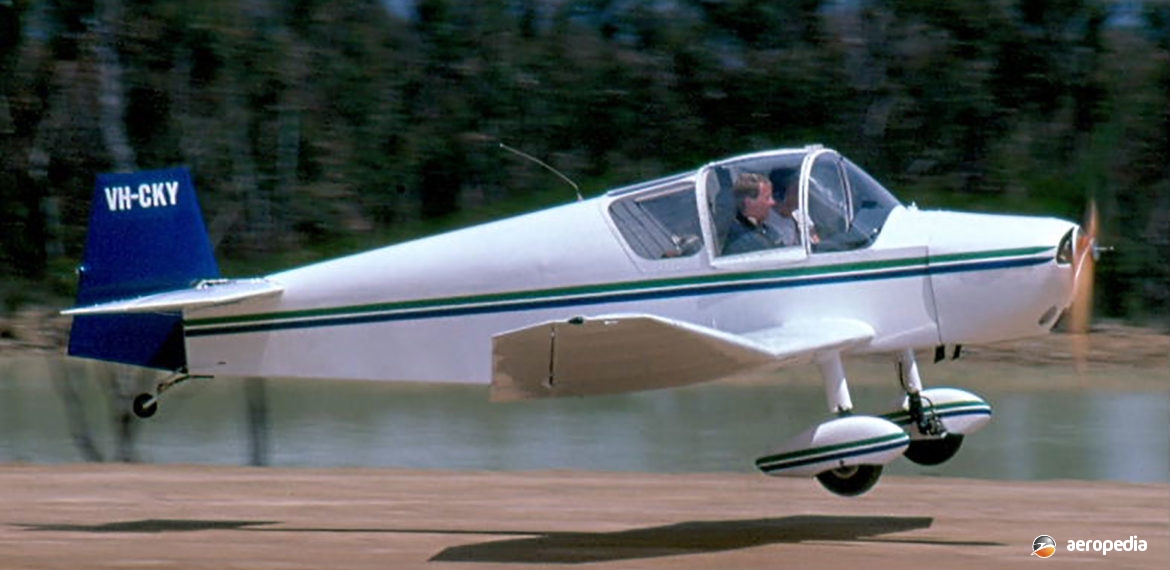Photograph:
Jodel D-11 VH-CKY (c/n W21) at Wedderburn, NSW (David C Eyre)
Country of origin:
France
Description:
Two-seat dual-control low-wing touring monoplane
Power Plant:
One 67 kw (90 hp) Rolls Royce/Continental O-200-A four-cylinder horizontally-opposed air-cooled engine
Specifications:
- Wingspan: 8.23 m (27 ft)
- Length: 6.46 m (21 ft 2 in)
- Wing area: 12.72 m² (137 sq ft)
- Never exceed speed: 249 km/h (155 mph)
- Max speed: 209 km/h (130 mph)
- Cruising speed: 209 km/h (118 mph)
- Landing speed: 80 km/h (50 mph)
- Stalling speed: 56 km/h (35 mph)
- Initial rate of climb: 244 m/min (800 ft/min)
- Ceiling: 5,182 m (17,000 ft)
- Take-off run: 137 m (450 ft)
- Landing run: 137 m (450 ft)
- Range: 1,151 km (715 miles)
- Fuel capacity: 100 litres (22 Imp gals)
- Power loading: 15 lb/hp
- Wing loading: 9.9 lb/sq ft
- Empty weight: 318 kg (700 lb)
- Useful load: 287 kg (632 lb)
- Loaded weight: 617 kg (1,360 lb)
History:
Designed as a two-seat development of the Jodel D-9, the D-11 became the basic model in a series of Jodel two-seat, light aircraft designs for amateur and commercial production. Excellent flying qualities established the type as the most popular French two-seater, and the handling qualities led to its adoption for some years as the standard training aircraft among French flying clubs.
The D-11 was essentially of simple but rugged construction. The one-piece cantilever wing had upswept, tapered outer panels, typical of most Jodel designs, with the inboard part of the wing being straight and flat. In other respects the construction was conventional using spruce and plywood with fabric covering. The wing was built on a single box-spar, which also supported the two legs of the wide track undercarriage. The undercarriage employed rubber in compression springing, and was fitted with light industrial wheels. The fuselage was of rectangular box structure with a curved spruce top decking and plywood covering. The tail was also plywood covered, while the elevator and rudder were fabric covered. Power plants ranging from 48 kw (65 hp) to 81 kw (108 hp) could be fitted, but the very popular Continental O-200 series was usually installed.
At one stage the Jodel D-11 was the most popular aircraft for amateur construction in this region, with over 20 completed in Australia and 30 in New Zealand. However, in numbers it has been well and truly overtaken by such modern types as the Stoddard Hamilton Glasair, Neico Lancair, Vans RV-4 and RV-6, etc.
In Canada the design of the D-11 was modified by Falconar Aircraft, these being known as the F-11A Sporty and the F-12A Cruiser. These had swept tail surfaces and could be fitted with engines up to 104 kw (140 hp), and folding wings. Examples of the Falconar models have been completed in New Zealand, an F-11A becoming ZK-KEA (c/n AACA/490) and an F-12 becoming ZK-DBI (c/n AACA/102) in November 1975. In Australia one of the first Falconar F-12As became VH-PKQ (c/n F8243) in November 2004.

